A Mystic Journey: Viking Days at Mystic Seaport Museum, Connecticut (Part One)
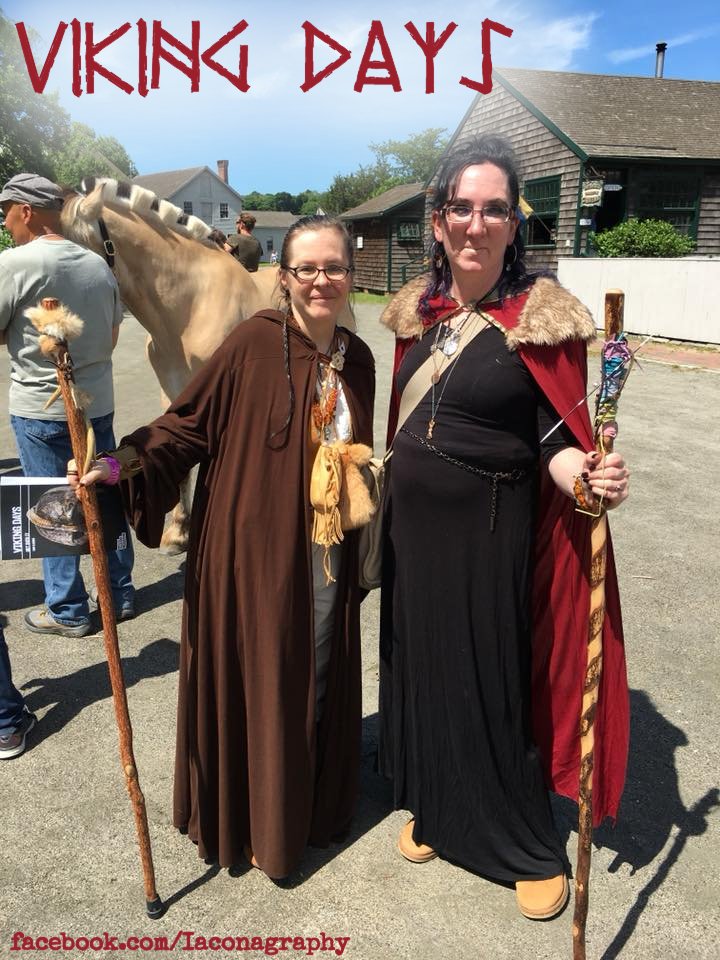
When the Vikings Begin Exhibition at the Mystic Seaport Museum in Mystic, Connecticut popped up in my Facebook feed completely by chance, I knew immediately that we had to somehow make the two hour drive to stand in the presence of the 10th century volva’s wand which they showed in their promo. Soon, we discovered the museum was also hosting a two-day event in conjunction with the exhibition: Viking Days. We had to go! We simply had to! We needed to be there to represent for our Heathen community: local, and not-so-local-via-Facebook.
So we did!
This was truly the chance of a lifetime.
The exhibition itself, The Vikings Begin, consists of a collection of grave objects from Valsgärde (a burial site north of Uppsala), curated by Charlotte Hedenstierna-Jonson, John Ljungkvist, and Neil Price, and produced by Gustavianum, Uppsala University Museum. The conventional view of Vikings as barbaric, violent opportunists (read: pirates) finds itself challenged, not only by the artifacts presented within the exhibition itself, but also via the ongoing research of its curators within the scope of their ongoing The Viking Phenomenon project.
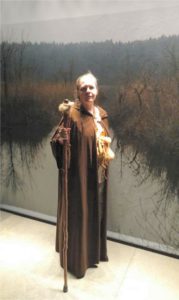

Entering the exhibit, one is greeted not by some pseudo-Wagnerian image of the warrior-pirate, but instead by views of the sea and the marshland; the sound of distant drums and “chanting” as the religious life of the Vikings unfolds against the back wall which you know you will arrive at eventually. The first artifacts might seem “small” to the non-scholar: an amber necklace from the 6th-9th century; coins from trade with other peoples. Yes: trade, not raids! The first portion of the exhibition focuses heavily on the Vendel Period–that period immediately preceding the so-called Viking Era–and the socio-political climate of that time, in an effort to explain the subsequent Viking Age, and how it came to pass.
There is a large chunk of the actual boat in which a 7th century warrior’s grave-goods were found (grave 8). Rounding the corner, there is a 2/3 scale model of that same boat, as it might have appeared when first crafted (and, yes, you can touch it!). This is set against backdrops of the open ocean. 
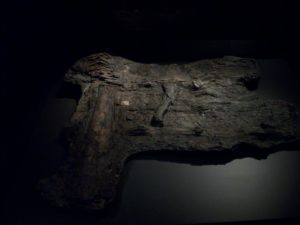
Rounding the next corner, one finds the weapons and helms of several warriors, as well as a recreation of a shield (Warrior grave-goods are a collection from Valsgärde graves 5, 6, 7, and 8). Upon a heavily decorated scabbard (grave 7): images of our Norse Gods. Where I expected to find myself immediately face-to-face with Tyr, or Odin, or even Thor, instead I discovered first and foremost at the top of the imagery what I can only describe as a depiction of Freyr. (I am not saying this depiction is definitively Freyr! I’m only an armchair archaeologist, and there were no accompanying descriptions by the curators of the artwork on the scabbard within the exhibition, nor within the exhibit book which I purchased.) At the bottom of the same scabbard: a pair of serpents form the rune Inguz. The sword is also decorated with the faces of falcons and possibly either ducks or owls. Coupled with the horse trappings, volva staff-head, and amber beads also on exhibition, my little Vanir-dedicated heart was skipping beats all over the place, and I had actual goosebumps!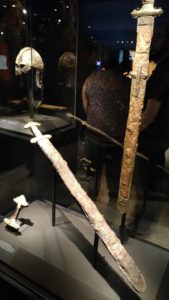
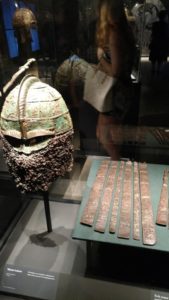
Later in the exhibition, one finds the ancient head of a volva’s staff, fashioned from bone (cremation grave 85), which appears to be the head of a magnificent cat (my own interpretation), as well as other mystical trappings (including a Jormungandr piece to which I had been previously exposed, from grave 4, and which helped shape the Jormungandr chapter in Norse Witch: Reclaiming the Heidhrinn Heart), and a short video presentation suggestive of feminine mystical practice among the ancient Norse (a dramatization).
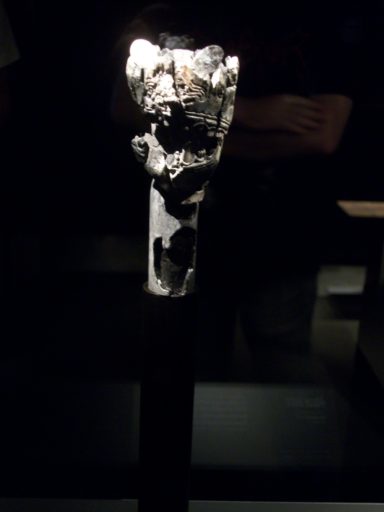
Perhaps the most striking items for the non-initiated (i.e., those who have a stereotypical view of Vikings), however, were the conical blue glass offering-cup and green bowl, both from Italy (graves 8 and 6, respectively), and a set of scales and weights from grave 12. Most would not expect items of such delicate beauty, nor “early Viking math”, from the stereotyped Viking.
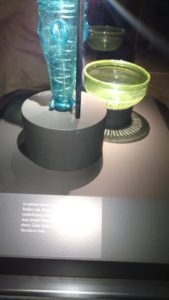
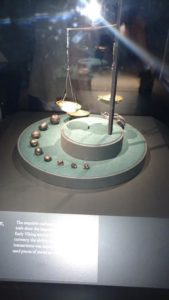
My only criticism of the exhibition is that to the average visitor, all of these objects might seem as if they came from one person’s grave, or even one pair of people (one man and one woman), when in fact, they are from a series of graves, all within the same region. The more interesting (and accurate) image of life, in my opinion, might be created by cataloging and displaying objects from each specific grave with their counterparts. As an example, let’s take a look at all of the items from grave 7:
Two heavily decorated swords (including the aforementioned “Freyr sword”)
A heavily decorated helmet (the animal motif suggests a boar; side images upon the helmet depict a warrior with a boar headdress)
A collection of spiral ornaments from a boat
A gilded silver ornament depicting a non-bearded man wearing a helmet
The metal remains of a shield (reconstructed on wood for the exhibition)
Further research into Valsgärde 7 led me to this wonderful webpage, which includes the recreation of the grave pictured below:

The offerings of horses, a pig, and cattle, coupled with that suggestive image of possibly Freyr on the scabbard and the boar-inclusive imagery on the helmet suggest a warrior not dedicated to Odin, or Thor, or even Tyr, as one might stereotypically expect, but instead a Freyrsman, who was as much a farmer and family man as he was a warrior!
For those interested, the wonderful exhibition catalog, with essays by the curators, is available for purchase here.
So how did visiting this exhibition shape my practice as a vitki, and/or my work as an author?
Thanks to this journey to Mystic, I have discovered an entire era of Nordic history which I have previously left unexplored, and which I feel goes largely ignored in the research of the larger community: the Vendel Period. Simply dipping my toe in that pond, I have discovered a plethora of Vanic imagery with a far lesser focus on Odin and the other Aesir. I find this tantalizing, and intend to dive much, much deeper!
As a vitki, I was struck by the adaptability of our Ancestors: an adaptability which is largely squashed in modern Heathen practice. The glass votive beaker, in particular, was stereotype-breaking. Working in a modern Heathen world which emphasizes the drinking horn as the “go-to blot vessel of choice”, I could not help but smile at the adoption of Italian glass in lieu of a cow-horn by whomever must have occupied Valsgärde 8. Observing the other items from that grave–an ornate helmet that appeared almost bearded–suggest that this was, in fact, a warrior’s grave. Yet clearly, this was a warrior with an appreciation for fine Italian glass, a most unexpected juxtaposition for the stereotype-laden modern mind!
The other thing which touched me as a vitki, reaching out to me from the past as though it were an embrace, was that our Ancestors clearly did not regard the Gods, nor even the World-Serpent, Jormungandr, as entities divorced from their daily life. Instead, They were ever-present, etched into the scabbards of swords and the sides of helmets and even the smallest fittings of their shields. Belief in Them, as Neil Price has pointed out in his writings, was not a question; it was a simple fact of existence. And rather than being portrayed as an ominous entity to be avoided, Jormungandr Itself is treated as a “thing that joins yet sets apart”, much as I describe It in my own book. I felt profoundly validated in my practice, and in my teaching of others. Money can’t buy that feeling!
I hope you will join me for the next two installments of this series, detailing our “Mystic Journey” to Viking Days at Mystic Seaport Museum in Connecticut, which will publish tomorrow (Wednesday) and Thursday, respectively, and will cover other immersive activities available at the event (including a performance by Lynn Noel, aka Gudrid the Wanderer, and a lecture by Dr. William Short of Hurstwic), as well as our tour of the Draken Harald Harfagre (the Viking ship).


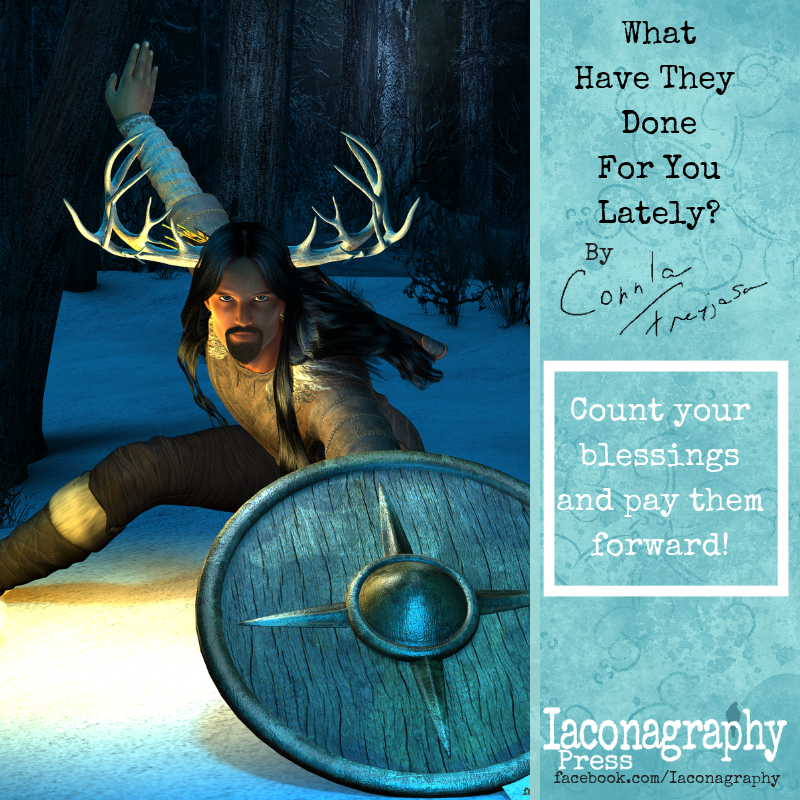
I love reading how this influenced you now. And , ears perk up at the Vanic influences.
I look forward to reading more of your findings and realize this may add to my reading list to find good collections of writings about the. Archeological finds and what is thought the stories they tell.
Thank you for sharing and towards parts II & III